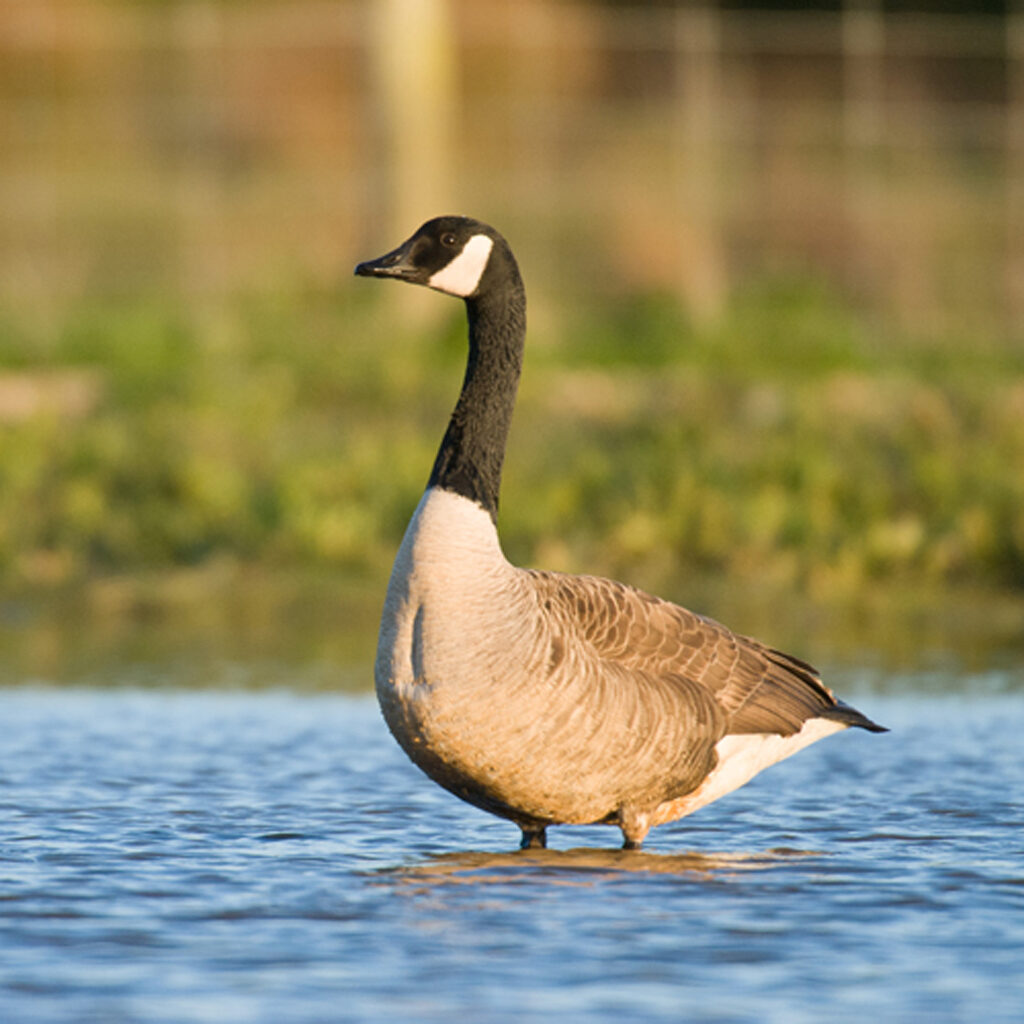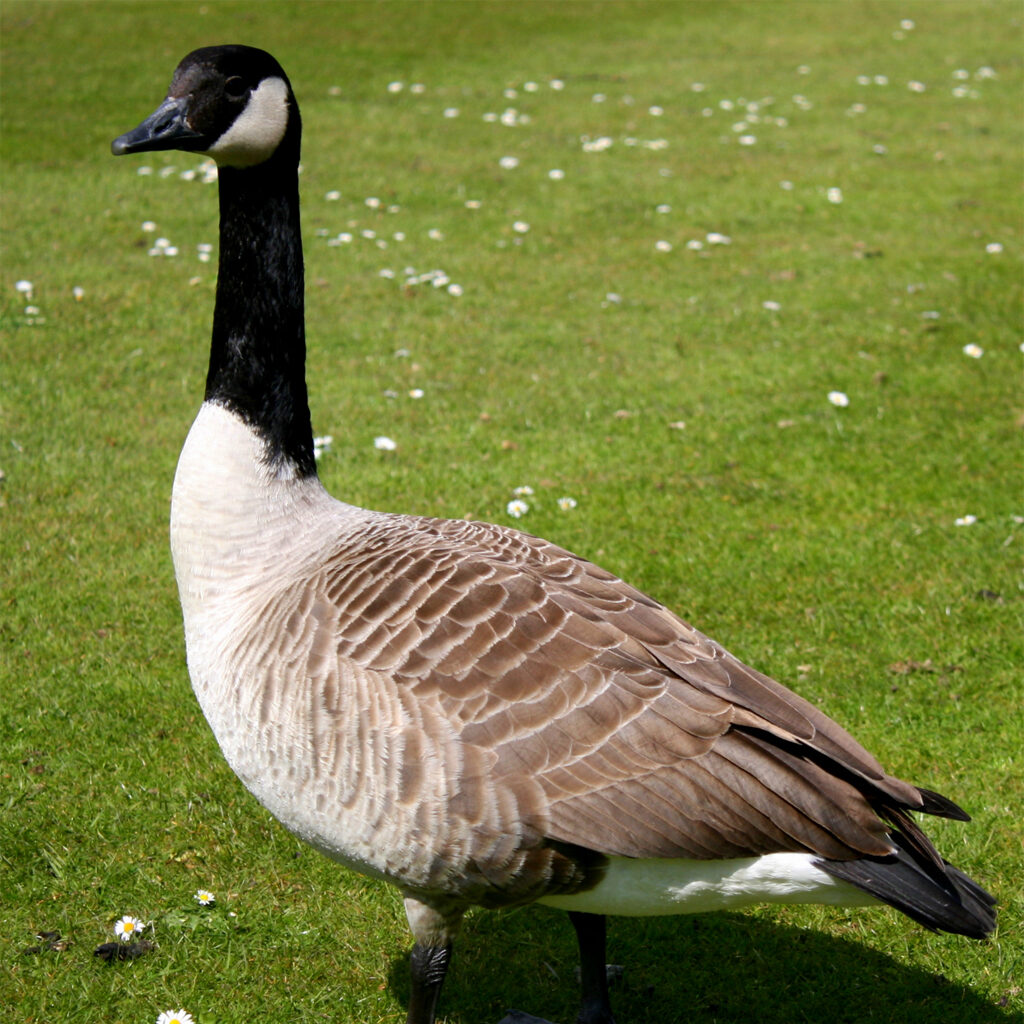Home / Wildlife Control Services in Vancouver / Geese Facts
Geese Facts
Everything You Need To Know About Geese
Habitat: Canada Geese can be found in most types of wetland. Although they are waterfowl, they spend as much time on land as they do in the water. They can also be found grazing on lawns of businesses, parks and on golf courses.


Breeding
How Often: Canada Geese mate once a year. They mate for life but if their mate dies, the goose will try to find another mating partner.
Location: Canada geese like to select nesting sites on elevated, secluded areas near bodies of water like lakes, streams, and ponds. The female goose builds a nest lined with plant material and down that she plucks from her body, and lays an egg each day in until a full clutch of up to 9 eggs are laid. The male geese acts as a sentry, watching the nest from a nearby location and attacking if anything gets too close.
Offspring: 2-9 eggs laid at a time.
Rearing: Baby geese, called goslings, are incredibly impressionable and will follow virtually anything that moves, thinking it to be their mother.
Less than 24 hours after they are born, goslings will be lead to water by their parents to learn how to swim. The goslings will be able to dive 30-40 feet underwater by the time they are 1 day old.
As they become more independent of their parents, groups of goslings may join together, forming “gang broods” of up to 100 goslings.
Goslings learn to fly between 2-3 months of age. For the first year of their lives, they stay with their parents, and will follow their parents during their first migration before forming into groups with other young geese.
Sexual Maturity: Canada Geese will begin searching for a mate between 2 – 3 years of age.
Food and Feeding
Canada geese are herbivores and primarily eat green vegetation, grasses, aquatic plants, and grains, but they do occasionally eat fish and insects.
In the spring and summer months, Canadian geese eat leaves, flowers, stems, roots, seeds and berries. They will often eat for 12 hours or more a day to consume a sufficient amount of nutrients. They feed even more intensively right before they fly north after the winter, storing energy for an active breeding period and preparing for a lack of food in the spring.
In urban areas, many of them will pick food off of the streets and even out of garbage cans.

Morphology and Lifestyle
Physiology: The Canada Goose is well known due to their distinctive black head, white cheeks, long black neck and webbed feet.
Body Size: 30 to 43 inches
Wing Span: Average wingspan is 4.2 to 5.6 feet. Their size is relative to a 6ft man.
Weight: Average weight varies between the subspecies, from 1.1kg for the cackling Canada Goose to 8kg for the Giant Canada Goose
Migration: Canada geese normally migrate to southern agricultural areas for the winter. To do so, they fly in the distinct “V” pattern, where one goose is the leader and its flock follows behind in a v-shape. This helps the geese save energy when they migrate, benefit from the air currents passing the leader, permitting them to fly longer distances. The v-shape also allows for an easier coordination of the flock’s movements, such as a change in flight speed or direction. The formation lets these changes be communicated quickly and efficiently to all geese in the flock. Some may decide to not migrate and stay in colder climates if food is available.
Call: Adult Canada Geese have about 13 different calls, ranging from low clucks and murmurs communicated while feeding and loud greeting and alarm calls. Goslings even start to communicate with their parents while they’re still in the egg. A gosling can make a call, or peep, if it’s distressed or content.
Lifespan: Canada Geese live around 10-25 years on average in the wild although some may live to be as old as 30 years old.
39 Years Of Wildlife Removal Experience
At Gates Wildlife Control, we offer professional and effective animal removal and prevention solutions to keep raccoons, squirrels, and skunks from entering your home. We also provide effective rodent control services for mice and rat infestations. Our team is trained and experienced in the installation of one-way doors, which allow the animals to exit your attic or walls, but prevent them from returning. Contact us today for a free consultation and quote,to keep these animals out of your home for good.
Raccoons, squirrels, and skunks are common animals that can cause damage and create nuisances when they move into your attic or walls. They can chew on wires, damage insulation, leave droppings and debris, and even carry diseases and parasites.
One-way doors are a humane and effective way to remove these animals from your home and prevent them from returning. The doors are installed over the entry points the animals are using to access your attic or walls. Once the animals leave to forage for food, they are unable to re-enter the space through the one-way door.
At Gates Wildlife Control, we have the knowledge and equipment to effectively install one-way doors for raccoons, squirrels, and skunks. Our team will also assess your home and identify any potential entry points that need to be sealed off to prevent future intrusions.
In addition to installing one-way doors, we also offer repair services for damage caused by the animals and provide screening of potential entry points. This includes fixing holes in the roof or walls to prevent water from coming into the roof and walls and installing screens over roof vents, soffits and chimneys.
Don’t let raccoons, squirrels, or skunks take over your attic or walls. Contact Gates Wildlife Control today for a free consultation and quote, and keep these pests out of your home for good with our one-way door installation services.

Morphology and Lifestyle
- Wing span: Big Brown Bats – 32 to 39cm; Little Brown Bats – 22 to 27cm.
- Weight: Big Brown Bats – 11 to 25g; Little Brown Bats – 5 to 11g.
- Vocalization: Bats use high frequency echo-location that is hard to hear with the exception of some clicking sounds.
- Lifespan: Between 10 and 20 years with the rare bat living as long as 30 years.
Did You Know?
- Bat fact: Bats play an important role in our environment as they can consume up to 3,000 insects in one night.
- Bat fact: Bats in Canada will not fly in your hair and suck your blood.
- Bat fact: Bats can spread the rabies virus when infected with very little to no evidence of contact.
- Bat fact: Bats can squeeze through a hole the size of a dime.
- Bat fact: A bat can produce several times its own weight in waste each month.
- Bat fact: Bat colonies can range in size from one to several hundred and can double in size every year.
- Bat fact: Bats hibernate when the temperature drops below 10 degrees C.
More About Geese

Humane Raccoon Removal

Humane Skunk Removal

Humane Squirrel Removal
Do It Yourself Dangers
For those who may be tempted to take on the task of removing animals and animal proofing themselves, it is important to remember that it can be a dangerous undertaking. Falling off ladders and roofs while attempting to remove animals or seal entry points can result in serious bodily harm. In some cases, even aggressive animals can pose a danger to those trying to remove them. It is best to leave these tasks to experienced professionals who have the knowledge and equipment to safely and effectively handle wildlife removal and animal proofing. Attempting to do it yourself can put you at risk of injury and potentially even more damage to your home.






















